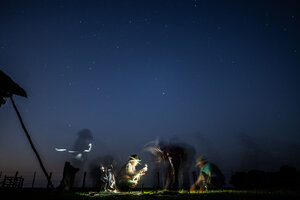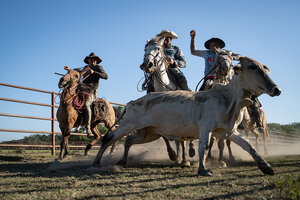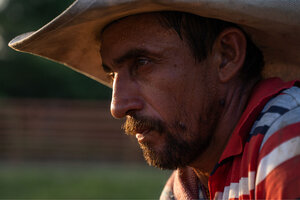In Pictures: Colombia’s cowboys keep tradition alive

"Llaneros" stretch a freshly skinned hide on a November night in Casanare, Colombia. These Colombian cowboys practice the centuries-old tradition of "trabajo de llano," labor of the plains.
Nathalia Angarita
Casanare, Colombia
Growing up on the Colombian plains, I developed an early admiration for el trabajo de llano, literally the labor of the plains. The term refers to a work ritual that’s been practiced here for centuries. It instilled in me a close relationship with the territory and the region’s customs.
Twice a year in May-June and November-December, ranchers hire llaneros, local cowboys who employ traditional cattle-driving practices. Livestock is the economic core of this region. But large industries producing crude oil, rice, and oil palm have displaced many ranches, disrupting the heritage of local llaneros, or people of the plains.
These cowboys travel on wild and hardy horses descended from those brought by the Spaniards in the 16th century. The horses became companions of the llaneros, traveling long distances across the vast plains of the Orinoco River basin, in the eastern region of Casanare, Colombia, in search of wild cattle. They herd the cattle through song, form a rodeo, and guide them through branding and vaccination.
Why We Wrote This
Traditions come and go. But the last cowboys of Colombia still find purpose in the centuries-old practice of cattle wrangling.
My grandfather was a traditional llanero, both a cattleman and horse tamer. He taught me to ride horses around when I learned to walk. I remember watching the cowboys gathering at 3 a.m. and sipping black coffee, preparing to start the strenuous work in the field.
Their day began below a starry sky with the butchering of a cow for their twice-daily meals. The work lasts 15 hours daily, and
el trabajo de llano can stretch from four to 45 days of strenuous work under the hot sun, depending on the number of cattle. Women, meanwhile, prepare the food and traditionally work in the house.
“Llano work is a way of life for me and I’m proud of my cowboy skills, but times have changed a lot,” says Oscar Acosta, adding that many traditional llaneros are aging and “the descendants no longer preserve the traditions of their parents.” Mr. Acosta started training as a llanero when he was a young boy. Now in his 40s, he works to carry on the tradition.


